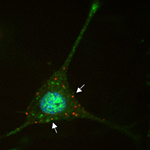A deficiency of uPAR alters endothelial angiogenic function and cell morphology
Main Article Content
Abstract
The angiogenic potential of a cell requires dynamic reorganization of the cytoskeletal architecture that involves the interaction of urokinase-type plasminogen activator receptor (uPAR) with the extracellular matrix. This study focuses on the effect of uPAR deficiency (uPAR -/-) on angiogenic function and associated cytoskeletal organization. Utilizing murine endothelial cells, it was observed that adhesion, migration, proliferation, and capillary tube formation were altered in uPAR -/-cells compared to wild-type (WT) cells. On a vitronectin (Vn) matrix, uPAR -/-cells acquired a "fried egg" morphology characterized by circular actin organization and lack of lamellipodia formation. The up-regulation of β1 integrin, FAK(P-Tyr925), and paxillin (P-Tyr118), and decreased Rac1 activation, suggested increased focal adhesions, but delayed focal adhesion turnover in uPAR -/-cells. This accounted for the enhanced adhesion, but attenuated migration, on Vn. VEGF-enriched Matrigel implants from uPAR -/-mice demonstrated a lack of mature vessel formation compared to WT mice. Collectively, these results indicate that a uPAR deficiency leads to decreased angiogenic functions of endothelial cells.
Article Details
How to Cite
BALSARA, Rashna D et al.
A deficiency of uPAR alters endothelial angiogenic function and cell morphology.
Vascular Cell, [S.l.], v. 3, n. 1, p. 10, may 2011.
ISSN 2045-824X.
Available at: <https://vascularcell.com/index.php/vc/article/view/10.1186-2045-824X-3-10>. Date accessed: 19 dec. 2025.
doi: http://dx.doi.org/10.1186/2045-824X-3-10.
Section
Original Research

